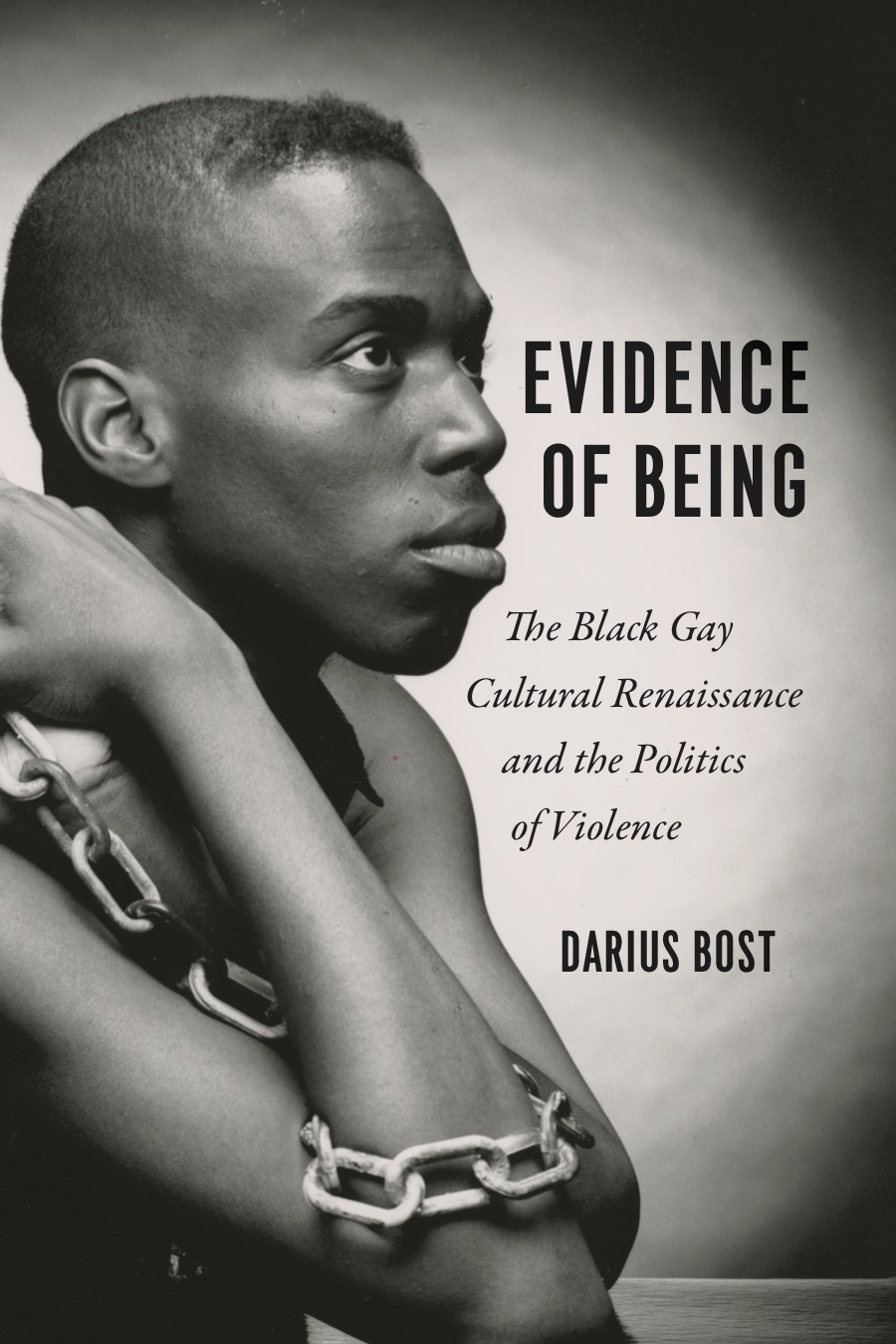
Review by Marcus Lee
Publisher: University of Chicago Press , 2018
Length: 192 pages
Awards and Honorable Mentions: Modern Language Association's William Sanders Scarborough Prize for the outstanding study of black American literature and culture. Honorable mention for the American Studies Association's Lora Romero First Book Prize.
What are the stakes in bearing witness to self-memorialization within black communities at a time when death dominates representations of blackness? How might the history of black gay cultural expression instruct new approaches to the study of race, sexuality, and collective life? And if the proliferation of black gay artists, intellectuals, and organizations during the late-20th century constitutes a renaissance, what is the measure of its legacy? Darius Bost pursues these questions in Evidence of Being through a recuperative analysis of black gay performance and literary history. Specifically, Bost traces black gay aesthetic and affective responses to late-20th century structural violence over four important cases: choral poetry and serial murder in Washington D.C. (Chapter 1); psychic alienation and collective longing in the writings of Essex Hemphill (Chapter 2); AIDS mortality and mourning in the works of the writers’ group Other Countries (Chapter 3); and trauma and hopeful uncertainty in Melvin Dixon’s diaries (Chapter 4). Each case necessitates recuperation because standard accounts of late-20th century politics and culture omit black gay life-worlds—analysts typically treat the period as one of dashed hopes and dead-ends, thereby rendering histories of black/queer struggles for alternative futures beyond consideration. Bost disputes the historiographic assumption of closure by taking the opening of black gay cultural imaginaries as his starting point.
One of the most striking features of Evidence of Being is the affinity between Bost’s research agenda and the political ambitions of his research subjects. For example, if Bost’s study entails historical recuperation, the subjects of his study embody the violence of historical erasure. As Bost details, black gay writers and activists interpreted late-20thcentury structural injustices—e.g. HIV/AIDS, imprisonment, welfare retrenchment, and state neglect—not only as circumstances of their mortality but also as threats to their historical being. In other words, they regarded marginalization in public life and excision from public memory as twin instantiations of racism and homophobia. Melvin Dixon’s 1992 OutWrite speech—which grounds Bost’s introduction—exemplifies this viewpoint. In the speech, Dixon contends that black gay men suffer a “double cremation,” first as targets of racism and again as targets of homophobia. The outcome of such a process is total obliteration or a form of devastation that leaves nothing behind. Dixon charges black gay men to guard against “double cremation” by becoming deliberate about fostering legacies, and he informs those responsible for historical production that he will be “listening for [his] name” (1).
Following Dixon, Bost’s account tracks how black gay writers and activists sought to self-memorialize and build legacies in the face of structural violence. That is if the ultimate outcome of structural violence is death and omission, black gay cultural expression insisted on living and remembrance. For instance, Bost illustrates a variety of black gay cultural practices that aimed to record memories of those felled by AIDS, including listing the names of AIDS victims in printed anthologies and holding alternative memorial services for those whose families refused to acknowledge their cause of death. Bost varyingly describes black gay men’s struggle against death and omission as efforts toward “textual survival” (97) and “archival permanence” (96), and he theorizes black gay men’s insistence on living as “black/queer optimism” (4).
Crucially, “black/queer optimism” functions as a key concept throughout Evidence of Being as it denotes the theoretical upshot of the project. If Bost takes interest in black gay men’s insistence on life and remembrance, he takes issue with the analytic protocols of Afro-pessimism and anti-social theory—two incommensurate frameworks that both “figure black queerness as a site of social death” (49). Bost argues that Afro-pessimism and anti-social theory privilege loss in their critical interpretations of blackness and queerness and therefore always imagine black/queer subjects as “dead or death-bound” (19). This, for Bost, is problematic on at least two counts. First, if black queerness only signifies social death to analysts of political and cultural history, then archives of black/queer collectivities become easy to disregard. (There seems to be an important relationship between the historiographic tendency to omit black gay life-worlds from 20th-century history and the analytic tendency to see black queerness only as a site of death.) Second, the overwhelming focus on death discounts the importance of cultural practices whose work exceeds the undoing of the body (19). Bost poses black/queer optimism as an alternative framework that accounts for what lives in excess of social death. Here, the stakes of the book’s title become clear: if theorists typically treat black queerness as only a site of death, or non-being, Bost takes archives of black gay cultural expression as sites of life and memory— as evidence of being.
Ultimately, Evidence of Being invites the reader to think with Bost about loss, historical production, and black gay subjectivity. I would like to offer a few questions that might extend this line of inquiry. First, to what extent is black gay men’s longing for historical recognition or “archival permanence” a function of their masculinity? Bost rightly interprets this longing within the context of black gay men’s marginalization in public life, but it might also be read alongside the incorporation of exceptional black men into national memory. Part of the strategy of racial integration in the late-20thcentury was the inclusion of heroic narratives of black men into U.S. history (see, for example, the creation of the Martin Luther King Jr. federal holiday in 1983). The logic behind this historical inclusion was that the exceptional bravery of some black men made them worthy of being remembered. Of course, black gay men’s status as sexual minorities disqualified them from this sort of inclusion, and the circumstances of their lives were much different from those of men like King or Malcolm X. Still, I wonder if the late-20th century discourse on exceptional black men conditioned their desire for historical recognition. In other words, to what extent was black gay men’s wish for “archival permanence” a longing to become “Black gay exceptionals” (Cohen 2004, p. 28)? On this point, reading Evidence of Being with Charisma by Erica Edwards (2012) and Terms of Order by Cedric Robinson (1980) might be clarifying.
Second, why is the longing for a life beyond the conditions of social death necessarily an instantiation of black/queer optimism? And, why does black/queer optimism exist necessarily in opposition to pessimism? Bost uses black gay men’s desires for more livable futures to push against Afro-pessimism and anti-social theory. However, neither framework denies the reality of subordinated groups holding on to the possibility of a more livable future; they may just interpret this longing as tragic or futile. (Working in a similar line of inquiry, Lauren Berlant (2012)—who is neither an Afro-pessimist nor an antisocial thinker—interprets optimistic attachment amid neoliberal adjustment as “cruel.”) But, what is Bost’s take on the theoretical infrastructures of Afro-pessimism and anti-social theory? What grounds their shared pessimism? Is it the tragedy of the archives selected for review? Or is the pessimism based on the disposition of the analyst? Likewise, where is Bost locating the optimism in his own account? For example, is it that Melvin Dixon’s diaries are an inventory of black/queer optimism? Or is Bost Melvin Dixon’s optimistic witness?
In closing, Evidence of Being is an important book that should impact the contours of Black and Queer Studies. Bost’s recuperation of the history of black gay cultural expression opens new lines of inquiry for scholars concerned with black sexuality, loss, history, and memory. Readers will find Evidence of Being moving, theoretically rich, and original.
References
Berlant, Lauren. Cruel Optimism. Durham: Duke University Press Books, 2011.
Cohen, Cathy J. “Deviance as Resistance: A New Research Agenda for the Study of Black Politics.” Du Bois Review 1, no. 1 (2004): 27–45.
Edwards, Erica. Charisma and the Fictions of Black Leadership. Minneapolis: University of Minnesota Press, 2012.
Robinson, Cedric. The Terms of Order: Political Science and the Myth of Leadership. Chapel Hill, N.C: The University of North Carolina Press, 1980.
Marcus Lee is a Ph.D. Candidate in Political Science at the University of Chicago. His research concerns African American and gay/lesbian politics in the late-20th century.
